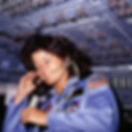Women in Space: Period.
- SATNAVmagazine
- Oct 4, 2021
- 2 min read
Updated: Mar 12, 2022
In this special World Space Week article, Anwesha Sahu discusses the challenges women have faced to become astronauts, and how menstruation is managed in zero-gravity.
Menstruation was once regarded as a valid reason to prevent women from becoming astronauts – after all, what if menstrual blood floats back in? How many tampons or pads would a female astronaut need to deal with menstrual blood in space? NASA engineers asked the same question to astronaut Sally Ride, “Is 100 the right number?”. I will not even try to answer that question.

Sally Ride, a physicist and astronaut, was the first American woman to travel into space.
NASA first allowed women into the astronaut corps in the year 1978, yet it was grossly unaware of how to deal with a completely new suite of astronauts, despite the success rate of the female candidates in the physical testing being 68% for the Mercury mission – 12% higher than the men!
Today, it is known that menstruation does not affect astronauts’ abilities, and neither does menstrual blood float back in – the female body knows it needs to be rejected. Female astronauts today have the freedom to choose how to deal with their periods.. Menstrual suppression is a viable option. Alternatively, the astronaut would have to consider hygiene practicalities in outer space. Water is a limited resource and changing sanitary products in the Zero-G environment of outer space is quite challenging.
Many astronauts on long-duration trips choose to suppress their periods, and the best option currently available to them is the oral contraceptive pill. However, this is a potential logistic issue for even longer term trips in future years – such as trips to Mars, which may typically be about three years. Such a trip would require roughly 1,100 pills. The associated logistics for coping with the transport and disposal of the pill packaging, and launching extra payload poses engineering challenges.
Supposing these issues are resolved, another concern would be the long-term effects of contraceptives on bone mineral density, while in outer space. Astronauts follow rigorous work-out routines to reduce the risk of osteoporosis and fractures as bone loss in Zero-G is far more significant than on Earth. While there is some evidence that contraceptives such as injections with synthetic progestogen may make such bone conditions worse, this is a field which requires significant research.
Space programs involving female astronauts have come a long way since 1978. With more provisions than before in place to make the trips as comfortable as possible, there has never been a better time to become an astronaut. As we celebrate women in space, I would like to leave you with a question, what does it really mean to be a woman in space?
From SATNAV Issue 23, page 10, For World Space Week 2021
_edited_edited.jpg)


